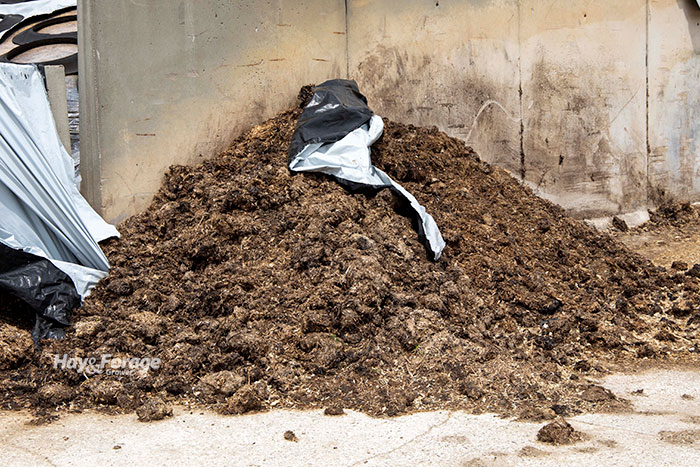Keep summer feed from spoiling |
| By Amber Friedrichsen, Associate Editor |
|
|
 If spoiled silage can make a farmer turn up their nose, it’s no wonder animals are deterred from taking a bite. Even though mitigating animal heat stress is top of mind this time of year, feed ingredients can suffer during summer weather, too — especially if they have low aerobic stability. In a publication written by extension specialists with the University of Wisconsin-Madison, aerobic stability is defined as the length of time a feed ingredient lasts before heating up or spoiling when it is exposed to oxygen. Moreover, heat and humidity can exacerbate aerobic stability, interfere with silage fermentation, and cause feed quality to decline. “These conditions allow for the rapid growth of yeasts, which use nutrients and lactic acid as sources of energy,” the extension specialists state. “The growth of yeasts sets off a chain reaction that starts with heating and leads to the loss of volatile acids, a rise in pH, the growth of undesired molds, and ultimately, instability.” Preventing spoilage starts with proper harvest and feed storage and continues with diligent feedout and feedbunk management. To ensure livestock have safe, palatable feed this summer, consider the following advice. Inoculate silage. Apply heterofermentative microbial inoculants that contain Lactobacillus buchneri to silage. This is the most frequently used bacteria in corn silage inoculants, and it safeguards against spoilage by converting lactate to acetate and 1,2-propanedial. These compounds have antifungal properties that inhibit yeast growth. The extension specialists note there are also inoculants with combinations of bacteria including L. buchneri that show promise in promoting aerobic stability as well. However, inoculants can only maintain feed quality — they are not solutions to poor harvest or storage practices. Such issues must be addressed before using these products. Pack silage densely. This is essential to exclude oxygen while silage is in storage, but also to maintain aerobic stability at feedout. The extension specialists say packing density is inversely proportional to the rate at which oxygen infiltrates a silage face. In other words, silage piles with higher packing densities have lower rates of oxygen penetration, which reduces feed loss. Monitor stored feed. Check silage bags and bunker plastic for tears and holes regularly and make repairs when necessary. If this becomes routine, identify the source of the damage. Animals are often to blame, so it may be beneficial to install fencing around storage areas or relocate silage bags in the future. After assessing the outside of plastic, make sure to evaluate what is inside, too. “Molds and mycotoxins need to be managed carefully,” the extension specialists advise. “Early detection is key to prevent further losses and make the best management decisions.” Remove the right amount of silage. No matter how well silage is packed and sealed, the extension specialists explain that air inevitably penetrates the face of silage piles and bunkers to about 35 inches deep. They suggest removing at least 12 inches of silage at a time to limit heating throughout the material remaining in storage. With that said, do not to remove too much silage that excess feed is wasted. “If feeding multiple times per day, also remove silage multiples times per day,” the extension specialists write. “Plan in advance to use smaller piles, silos, or bags during summer. This is a good way to minimize spoilage at the silage face.” Furthermore, use a facer to remove silage from a pile or bunker instead of a bucket. The former will leave a smooth face, reducing the surface area exposed to air. Using a facer also mitigates the risk of overhangs in a silage face, which can be hazardous to farmers and cause feed avalanches. Manage total mixed rations. In addition to silage, consider the other ingredients incorporated in total mixed rations (TMRs). Omit feedstuffs that are subject to heating and spoilage like wet brewers grains or wet distillers grains, and treat TMRs with buffered acids or preservatives to hinder yeast proliferation. Another way to support aerobic stability in TMRs is to adjust feeding times. The extension specialists recommend feeding twice a day when temperatures are cool, such as early in the morning and later in the evening. This schedule aligns with eating patterns observed in cows under heat stress and will lessen TMR waste and spoilage. For additional information, view “Summer feed storage and feedbunk management.”  Amber Friedrichsen Amber Friedrichsen is the 2022 Hay & Forage Grower editorial intern. She currently attends Iowa State University where she is majoring in agriculture and life sciences education-communications and agronomy. Friedrichsen grew up on her family’s diversified crop and livestock farm near Clinton, Iowa.
|
